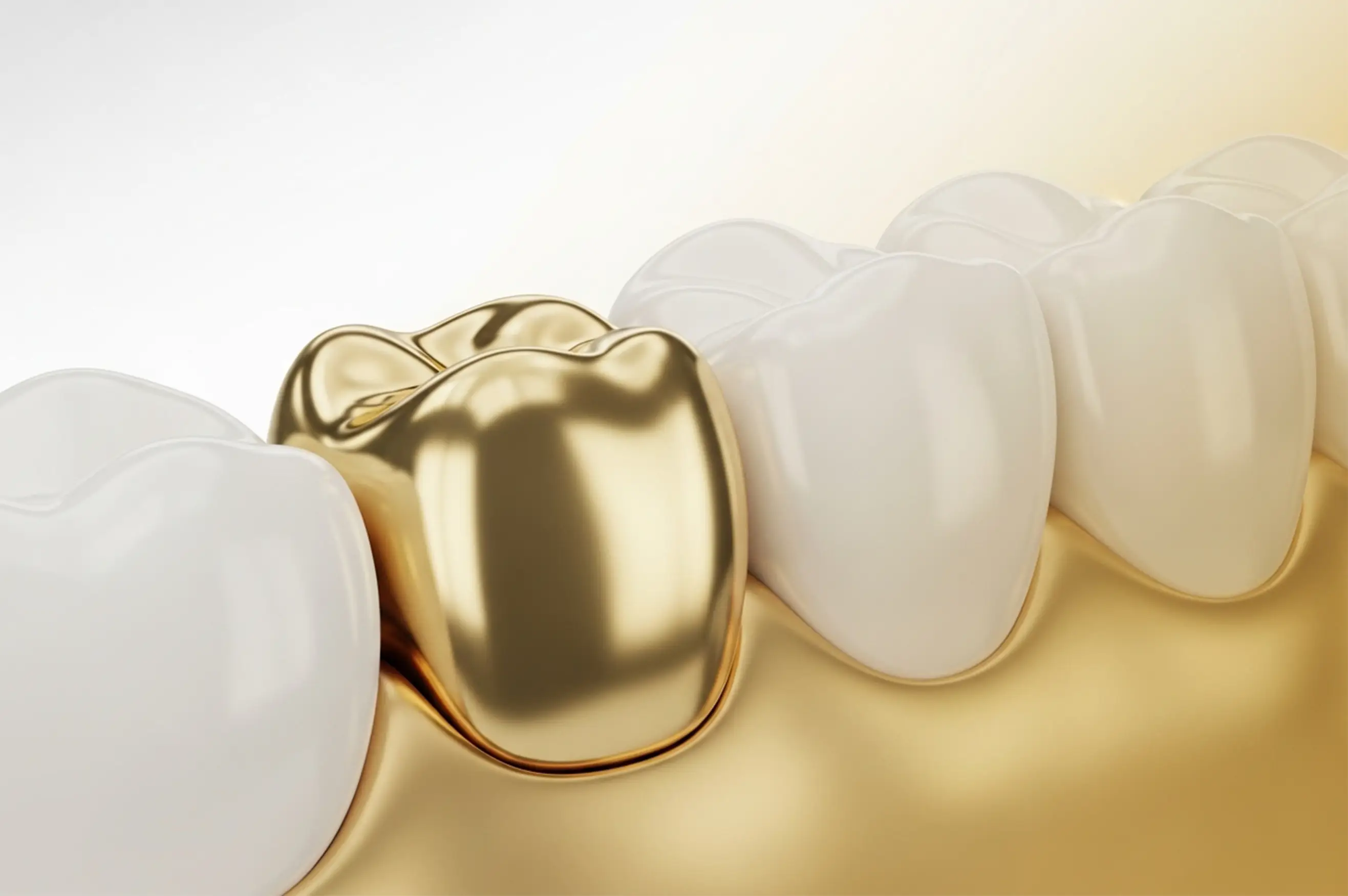Gold Dental Crowns: Cost, Benefits, and Disadvantages | Gold Teeth & Crowns in Turkey
Gold Dental Crowns: Cost, Benefits, and Disadvantages | Gold Teeth & Crowns in Turkey
Discover the cost, benefits, and disadvantages of gold dental crowns. Learn about prices in Turkey, durability, side effects, and how gold crowns compare to porcelain.
Table of Contents
- What Are Gold Dental Crowns?
- Why Choose Gold Crowns for Teeth?
- Types of Gold Crowns
- Gold Crown Tooth Procedure
- Benefits of Gold Crowns
- Disadvantages and Side Effects of Gold Crowns
- Gold Crowns vs Porcelain and Zirconia
- Gold Crown Cost and Prices in Turkey
- Are Gold Crowns Still Used Today?
- FAQs About Gold Crowns
What Are Gold Dental Crowns?
Gold dental crowns are tooth-shaped caps made from a gold alloy that cover damaged or decayed teeth to restore their strength, shape, and function. These crowns have been used in dentistry for over a century and remain popular among patients who value durability and longevity over aesthetics.
A typical gold crown isn’t made from pure gold — instead, it’s a mix of gold with metals like copper, nickel, or palladium. This combination enhances strength while keeping the crown gentle on surrounding teeth.
Read More: Dental Crowns in Turkey
Why Choose Gold Crowns for Teeth?
Gold crowns are often chosen for molar teeth, where durability matters most. Dentists recommend them for patients who grind their teeth (bruxism) or have strong chewing forces.
They’re also less likely to chip or break compared to porcelain or resin crowns, making them an excellent long-term choice for back teeth that do most of the chewing.
Types of Gold Crowns
Gold crowns come in several types, depending on gold content and appearance:
-
Full gold crowns: Made mostly of gold alloy; known for maximum durability and minimal wear on opposing teeth.
-
Partial gold crowns (inlays/onlays): Cover only part of the tooth, preserving more of the natural structure.
-
High noble alloy crowns: Contain at least 60% noble metals (including gold), offering a balance between performance and cost.
Gold Crown Tooth Procedure
The process of getting a gold crown typically involves two dental visits:
-
Tooth preparation: The dentist removes decay and shapes the tooth for the crown. An impression is then taken to create a custom fit.
-
Temporary crown placement: A temporary crown protects your tooth while the permanent one is made in a lab.
-
Permanent crown fitting: On your second visit, the dentist cements the gold crown permanently, ensuring a secure and comfortable bite.
Gold crowns are custom-crafted for each patient, ensuring precision and a long-lasting fit.
_1761822641.webp)
Benefits of Gold Crowns
Gold crowns are prized for their reliability and long-term performance.
Key benefits include:
-
Exceptional durability: Gold crowns can last 20–40 years or more with proper care.
-
Gentle on natural teeth: They wear evenly and are less abrasive than porcelain.
-
Precision fit: Gold’s flexibility allows a tighter seal, reducing the risk of decay beneath the crown.
-
Corrosion resistance: Gold doesn’t rust or degrade, maintaining its integrity for decades.
-
Biocompatibility: Gold is generally well-tolerated by gum tissue, with minimal irritation.
Read More: Types of dental crowns and cost in Turkey
Disadvantages and Side Effects of Gold Crowns
While gold crowns are known for their durability and long lifespan, they aren’t without drawbacks. Understanding the potential downsides helps patients make an informed decision before treatment.
Aesthetic concerns:
Gold crowns are highly visible, which makes them less ideal for front teeth or those who prefer a natural-looking smile. They’re often chosen for molars where they’re less noticeable.
Cost:
Gold is a precious metal, so these crowns typically cost more than other materials like porcelain or zirconia. The price depends on gold content, the dental clinic, and location.
Temperature sensitivity:
Gold conducts heat and cold more efficiently than porcelain, which may lead to temporary sensitivity, especially right after placement.
Wear on opposing teeth:
Although gold is softer than porcelain, it can still cause mild wear to opposing natural teeth over time — especially if the bite alignment isn’t perfect.
Additional possible side effects:
In some cases, patients may also notice other less common effects, such as:
-
Galvanic shock: When a gold crown touches another metal restoration (like an amalgam filling), it can cause a brief electric-like sensation due to interaction between the metals.
-
Metallic taste: A temporary metallic flavor in the mouth is sometimes reported after placement.
-
Gum discoloration: The gum tissue near a gold crown may appear slightly darker or grayish over time because of the metal content.
-
Allergic reaction: Rarely, people sensitive to certain metals in gold alloys (such as nickel or palladium) might experience mild gum irritation or redness.
These side effects are uncommon and typically temporary. Most patients adjust quickly, and any metallic taste or sensitivity usually fades within a few weeks.
Gold Crowns vs Porcelain and Zirconia
When choosing between gold, porcelain, and zirconia crowns, each has distinct advantages:
|
Feature |
Gold Crowns |
Porcelain Crowns |
Zirconia Crowns |
|
Durability |
Excellent (20–40 years) |
Moderate (10–15 years) |
Excellent (15–25 years) |
|
Appearance |
Metallic, visible |
Natural-looking |
Natural-looking |
|
Comfort |
Gentle on teeth |
May chip or crack |
Very strong but harder on opposing teeth |
|
Cost |
Higher |
Moderate |
Moderate to high |
|
Best for |
Back molars |
Front teeth |
Both front and back |
Gold Crown Cost and Prices in Turkey
The cost of a gold dental crown varies based on gold content, clinic reputation, and location.
-
Average global price: $600–$2,500 per crown
-
Gold crown cost in Turkey: typically $400–$800 per crown, depending on the karat level and dentist’s expertise.
Turkey’s dental clinics are known for high-quality care and affordability, making it a popular destination for patients from Europe and the Middle East seeking gold dental crowns or other cosmetic treatments.
Read More: Dental implant cost in Turkey
_1761822666.webp)
Are Gold Crowns Still Used Today?
Yes — even with modern materials like zirconia and porcelain, gold remains a trusted choice for durability and biocompatibility.
Some dentists still recommend gold crowns for molars and patients who prioritize long-term strength over appearance. The material’s proven track record and performance continue to make it a viable option in restorative dentistry.
FAQs About Gold Crowns
Are gold crowns real gold?
Most gold crowns contain a gold alloy (not pure gold), typically ranging from 10 to 22 karats.
Is a gold crown good for teeth?
Yes. Gold crowns are durable, gentle on opposing teeth, and resistant to wear, making them ideal for molars.
Why don’t dentists use gold crowns as often today?
The main reasons are aesthetics and cost. Many patients prefer tooth-colored materials like zirconia or porcelain.
Can I get gold crowns on front teeth?
Yes, though it’s uncommon. Some people choose gold for aesthetic or cultural reasons.
Do gold crowns set off metal detectors?
No — dental gold alloys are not magnetic and don’t trigger alarms.
Final Thoughts
Gold dental crowns remain one of the most durable and biocompatible restoration options available. While their metallic look and higher price may not suit everyone, their longevity and comfort make them a top choice for molars and back teeth.
For patients seeking gold dental crowns in Turkey, the combination of skilled dentists, advanced technology, and competitive pricing makes it a smart and reliable choice for long-lasting dental work.
Sources
Fill it out to get your free consultation
Innovation & Precision In Every Implant
We use only reputable, high-quality implants designed for long-term durability
BioTec Dental Implants


Hiossen Dental Implants


Straumann Dental Implants


Nobel Biocare Dental Implants


MegaGen Dental Implants








